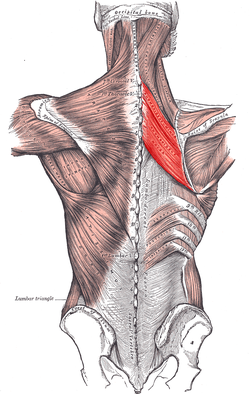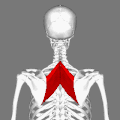|
Rhomboid muscles
The rhomboid muscles (/ˈrɒmbɔɪd/), often simply called the rhomboids, are rhombus-shaped muscles associated with the scapula. There are two rhomboid muscles on each side of the upper back:[1][2][3] The large rhombus-shaped muscle, located under the trapezius muscle, in the upper part of the thoracic region of the back, and the small muscle, in the same way, participate in the movement of the scapula.[4] Their functions are the following:[1][2][3]
Both muscles are innervated by the dorsal scapular nerve, a branch of the brachial plexus.[1][2][3] Additional images
... ReferencesWikimedia Commons has media related to Rhomboid muscles.
|
||||||||||||||||||||||




